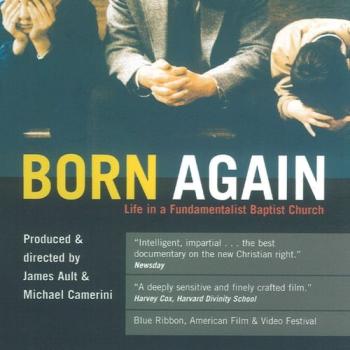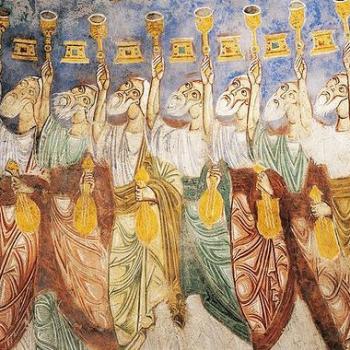*The opinions expressed here are my own (or those of the guest writer); I do not speak for any other person, group or organization; nor do I imply that the opinions expressed here reflect those of any other person, group or organization unless I say so specifically. Before commenting read the entire post and the “Note to commenters” at its end.*
Review of a Fascinating New Book from Greg Boyd (and Friends): The Cosmic Dance
Some time ago here I raised a question about God and time. The question keeps coming up for those of us who believe God is, in some sense, “in time,” or that time is real for God in the sense that the future is also future for him. There are many Christian (and perhaps other) theologians and philosophers of religion who have adopted this view of God and time and rejected the more traditional view of classical Western theism that God is somehow “above” or “outside of” time—existing in an “eternal now” in which all times, past, present and future, are simultaneously before his eyes.
This “God in time” or “God everlasting” is my view and has been for many years—at least since I read Christian philosopher Nicholas Wolterstorff’s magnificent essay “God Everlasting” which has now been published in several collections of essays. (I first read it in God and the Good: Essays in Honor of Henry Stob (Eerdmans, 1975). Around the same time I read God and Timelessness by Nelson Pike (Schocken Books, 1970). And I read books and essays about this subject by theologians such as Robert Jenson who, long ago, in his earliest books, seemed to me to be advocating a “God in time” view. It also seemed to me that T. F. Torrance was advocating such a view in Space, Time, and Incarnation (Oxford, 1969).
All this was happening long before anything called “open theism” was “in the air,” but I was seeking an alternative view of God and time to that of Process Theology—one that did not require denial of God’s omnipotence. It has long seemed to me that the biblical narrative assumes that God exists in time such that our future is also future for him and that the “classical view” (God as living in an “eternal now”) undermines our ability to have any effect on God—something I found and still find important to the biblical worldview including prayer.
I do not want to launch here a new round of discussion or debate about this; I only want to mention and recommend a new book that at least attempts to answer a frequent question raised by intelligent people about the God-within-time view (“divine temporality”). The question is this: Does not relativity theory falsify belief that an omnipresent being such as God can be temporal? In other words, if, as relativity theory says, space and time are inseparable such that a being who is everywhere in the universe would be both “ahead” and “behind” us in time, must we not accept the classical view of God as “outside of time” (divine non-temporality)?
I asked that question here and received numerous suggestions for further reading; I’m sorry to say that I was not able to follow up on all of them. I did look into some and decided I was/am not prepared to understand modern/contemporary physics including relativity theory. What I did find was that seemingly equally astute experts on the subject disagree about the “God and time” question.
I have no idea whether Greg Boyd (and friends) was (were) “listening in” to that discussion here. All I know is that, coincidentally (or not) I recently received in the mail from the publisher Greg’s most recent book entitled The Cosmic Dance: What Science Can Teach Us about the Nature of Time. Life, God & Humpty Dumpty (ReKnew Publishing, 2016). (The book does not appear to be available via Amazon or other resellers so here is the web address: www.reknew.org.)
First of all, a disclaimer: I am far, far from an expert or even knowledgeable person about relativity theory, quantum physics, or any of the other extremely (to me) esoteric subjects discussed in this book (viz., The Cosmic Dance). Second of all, all I can do here, in terms of assessing the claims made about these subjects in the book, is take the author’s (authors’) word for it. I have not read the many books he/they quote and reference. I have read a few of them, but not most of them.
The Cosmic Dance is Greg’s (and friends’) attempt to present the case that the best contemporary science supports viewing time as an “arrow” such that an omnipresent being (such as the God of traditional Christianity) would not “already be” in the future or “still be” in the past but would experience the future as not yet and the past as no longer available. In other words, the book argues, using numerous quotations from and references to modern and contemporary physics, that relativity theory, as understood through post-Einsteinian physics, supports an “open view” of the universe and the future in which real novelty and spontaneity characterize events within an overall interconnected whole of reality.
When I read a book I often try to find a key paragraph that sums up its main “big idea” or single most important thesis. Here is my candidate for that in The Cosmic Dance: “In this book we’ve argued that Quantum Theory, Chaos-Complexity Theory and Non-equilibrium Thermodynamics suggest that a fully deterministic description of the world is impossible, and that time and novelty are more than mere illusions. We’ve argued that even Relativity Theory gives a role to time that is very different from space. This all suggests that reality moves from a settled past into a partly open future.” (184)
Readers of The Cosmic Dance will immediately see, and either be delighted or annoyed by, its unique design. It is by the author’s/authors’ own admission a “Dick and Jane picture book” meant to entertain as it informs and seeks to persuade. (“Dick and Jane” refers to the old first grade reading books used in public schools in the United States years ago: “See Dick run; see Jane throw the ball,” etc.)
For myself, I have already decided and steadfastly maintain that the biblical narrative represents God in time with us. If there is that of God that is “outside of time” in some “eternal now” in which all our “times” are “simultaneously before the eyes of God” (Pannenberg), I cannot reconcile that with the vividly interactive portrayal of God in Scripture or talk about it except by referring to God as a “great unblinking stare” (Dallas Willard’s description of the philosophical-theistic view which he rejected) who cannot be affected by what happens within time.
For now, at least, I find The Cosmic Dance supportive of what I believe the Bible indicates about God’s historicity in relation with the world. I’m aware of all the objections including that, somehow or other, God can be both “inside of time” and “outside of time,” but I am unconvinced. Nothing in the biblical narrative leads me to think of God as at all “outside of time.”
I will just say this about one point in The Cosmic Dance: I do not think it treats the classical Arminian view fairly. It implies that Arminianism is deterministic; it is not. Apparently Greg (and friends) think that if God foreknows with perfect certainty all that will be and happen, all that will be and happen is determined and there is no free will or contingency in the future. So, the book advocates open theism as the only alternative to divine determinism. I disagree. But I realize that my view requires appeal to a mystery—how God within time foreknows the future perfectly but non-deterministically. I can live with that mystery. Open theism involves mysteries I so far cannot embrace or live with such as how God can “predestinate” individuals without perfect foreknowledge of their free decisions of faith. But I consider this a minor point of disagreement among Arminians, not something we have to divide over.
There are some serious tongue-in-cheek “moments” in The Cosmic Dance that gave me smiles. On page 13 Greg (pictured with a “balloon” of what he is saying) says that some people find open theism “rather controversial.” Immediately below that is a pencil drawing of a theologian saying “To say the least!” Can anyone else tell who that unnamed theologian is? Then, on page 101 there are three small photos of Greg Boyd—as a child, as a teenager, and as he looks now. They are meant to illustrate his comment—in a cartoon “balloon” coming from his mouth—that “Though some things deteriorate faster than others.” The pic of him as a teenager (or young man) is absolutely hilarious!
I can heartily recommend this book for the pictures if nothing else! Seriously, however, if you are interested in reading a case made from science that time is “for real” and not illusory, and that although time and space are, indeed, inter-related that does not mean an omnipresent being must somehow already be “in the future,” buy the book. Make of it what you will. But don’t review it here. I simply don’t have time to read others’ reviews. Brief comments about it are welcome (from people who read the book). I doubt I can answer questions about the science. But let’s see if anyone else can discern who the unnamed theologian on page 13 is.
*Note to commenters: This blog is not a discussion board; please respond with a question or comment solely to me. If you do not share my evangelical Christian perspective (very broadly defined), feel free to ask a question for clarification, but know that this is not a space for debating incommensurate perspectives/worldviews. In any case, know that there is no guarantee that your question or comment will be posted by the moderator or answered by the writer. If you hope for your question or comment to appear here and be answered or responded to, make sure it is civil, respectful, and “on topic.” Do not comment if you have not read the entire post and do not misrepresent what it says. Keep any comment (including questions) to minimal length; do not post essays, sermons or testimonies here. Do not post links to internet sites here. This is a space for expressions of the blogger’s (or guest writers’) opinions and constructive dialogue among evangelical Christians (very broadly defined).
















